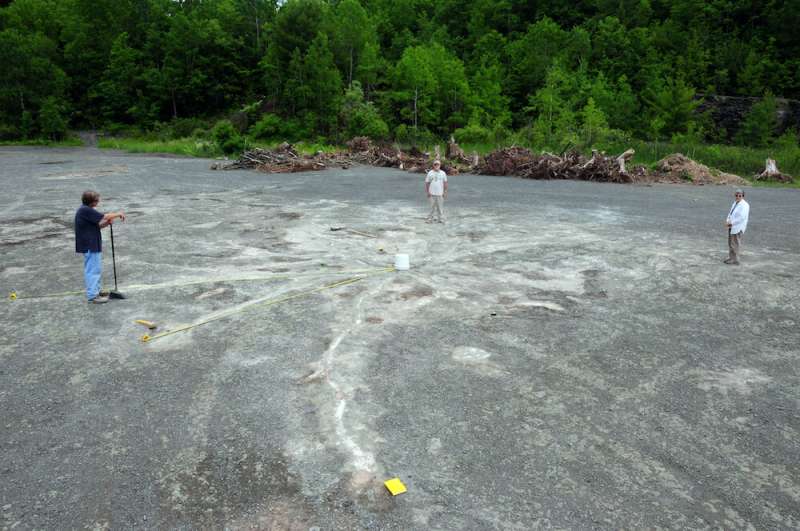Ancient New York: Research gives a snapshot of the oldest forest in the world

Under the gray stone of a municipal highway department quarry, the oldest trees in the world left traces of their roots beneath a ridge and forest pool 385 million years ago.
Khudadad, a Binghamton University doctoral candidate in biological sciences, reconstructed this primeval world in a recent paper, "A Middle Devonian vernal pool ecosystem provides a snapshot of the earliest forests," published in the journal PLOS One. (Khudadad uses a single name.)
Khudadad's research centered on an ancient ecosystem in what is today the Town of Cairo in Greene County. New York state was home to some of the oldest forests in the world; a similar site in Gilboa in Schoharie County, N.Y., first made headlines a century ago. Emeritus Professor of Biological Sciences William Stein has also published several academic papers about the ancient trees, which have received renewed interest since a root system was discovered at the Gilboa site in 2012.
New York looked far different during the Middle Devonian period, when trees first began colonizing the land. Located in the Southern Hemisphere, it had a semi-arid climate, although most of the landscape was still barren. Even the skies were different in character: the atmosphere had three to five times the level of carbon dioxide that it does today.
So what did those early forests look like? Illustrators typically draw on the example of the Gilboa forest, which was dominated by the fern-like trees known as Eospermatopteris; the trees' bulbous bases and roots were preserved in a sand cast, which gave the impression of trees adapted to river deltas, similar to mangroves. As a result, drawings depicting the Middle Devonian often show environments similar to modern rainforests, Khudadad explained.
When he researched the Cairo site, however, he found something different. This ancient forest, even older than the one in Gilboa, lay along an abandoned river-channel and low spot that filled seasonally with water, creating a vernal pool in an otherwise arid climate. And unlike Gilboa, it had a mix of trees: Eospermatopteris and the conifer-like Archaeopteris together, and even a possible lycopsid tree, related to today's club moss.
"This finding suggested that the earliest trees could colonize a range of environments and weren't limited to the wet environments," Khudadad said. "Not only could trees tolerate drier environments, but also the harsh environments of the expansive clays that dominated Catskill plains."
Mountains and rivers
Over the course of hundreds of millions of years, New York's Catskill mountain range has eroded, and it lacks the lofty heights of the Himalayas. But 385 million years ago, the range was still young and growing taller.
Those ancient mountains were the source of the Catskill river and associated delta systems that once irrigated New York's plains during the Middle Devonian period. In much the same way, today's Himalayas are the source of the Indus, Ganges and Brahmaputra river systems that irrigate the plains of Pakistan, India and Bangladesh.
The Catskill river system played an important role in establishing early forests such as the ones in Gilboa and Cairo. As it snaked along the plains and eventually widened, it formed deltaic environments that supported Eospermatopteris, Khudadad said.
These early fern-like trees weren't much like the oaks and willows of today. They lacked the branched roots of modern trees and had relatively small amounts of wood in their structure. Because they reproduced by spores rather than seeds, scholars believe they were unable to move out of the wet delta areas into drier environments.
Enter the Archaeopteris, which are similar to today's conifers with woody roots that reached deep into the ground and branched out. Because of its advanced features, researchers believed that Archaeopteris trees colonized the drier upper sections of river systems, while Eospermatopteris dominated the wetter deltas. But ancient ecosystems were more diverse than previously thought.
In Cairo, the young Catskill mountains provided minerals that created clay soils, which expanded and shrank in the vernal pool during seasonal wet and dry cycles. The soil churned and developed permanent hardened surfaces that tree roots had to navigate around. Researchers also theorize that the evolution of early trees changed river systems by stabilizing their banks.
"While there were young opportunistic forests, the mature forest was established on stable landscapes such as distal floodplains. By learning about the roles of abandoned channels and seasonal pools in distal floodplains, we now have a better understanding of how rivers played a key role in shaping the forest ecosystems," Khudadad said.
The diverse, early forests that grew up around ancient river systems in places such as the Catskills played a major role in greening the Earth. Just as the roots of more complex trees branch off in different directions, the current findings may also inspire new avenues of research on the sedimentary, pedological and ecological processes connected with this period.
"Since the earliest trees had diverse morphologies, there is a need for better understanding of the selective pressures that drove the evolution of such morphologies," Khudadad said.
More information: Khudadad et al, A Middle Devonian vernal pool ecosystem provides a snapshot of the earliest forests, PLOS ONE (2021). DOI: 10.1371/journal.pone.0255565
Journal information: PLoS ONE
Provided by Binghamton University





















